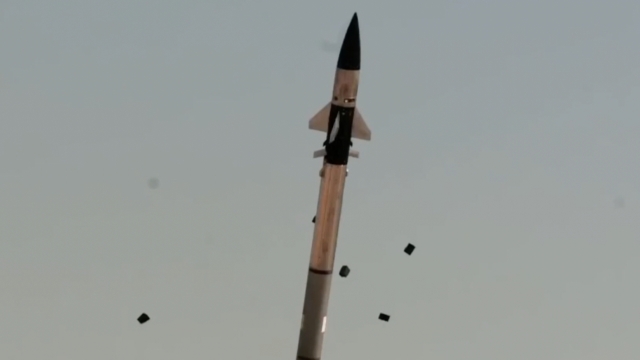High over Israeli territory, a volley of rockets explode midair. It's the work of one of the most advanced ground-based aerial defense systems in the world.
"It has saved countless lives, not just in Israel, but on the other side of the borders as well," said Steve Zipperstein, a distinguished senior fellow at UCLA Center for Middle East Development.
Here's how it works:
- A radar system monitors for more than a thousand aerial targets at a time and finds incoming rockets.
- A computer then determines whether the rocket is headed for populated areas.
If it is, it sends a message to fire a guided missile to destroy the rocket.
"You have very limited time to find some kind of secure place, 30 seconds at most, before either the interceptor works, or if it's not one of the ones that it can take out, then you're going to be put in jeopardy if you didn't go into a basement or a bunker somewhere," said Howard Stoffer, an international affairs professor at the University of New Haven.
Israel reportedly has at least 10 batteries of interceptor missiles around the country.
Each are designated to defend about 90 square miles with some 60 missiles, according to an analysis from the Center for Strategic and International Studies.
SEE MORE: State Department: American death toll in Israel increases to 22
That's 600 missiles — locked and loaded ready to intercept rockets on a moment's notice.
"You can imagine, not speaking of the current war, but in the prior rounds of conflict when Hamas fired rockets into Israel. Thousands of rockets in the prior conflicts in 2021 and 2014 and 2009. If those rockets had not been intercepted and had landed and killed Israeli civilians, the Israeli retaliation would have been far, far more comprehensive, resulting in far more deaths on the Palestinian side of the border," said Zipperstein.
The system was put into development in the mid-2000s. It became operational in 2011, with a good chunk of financing from the U.S.
U.S.-based Raytheon helped supply some of the technology for the system, and the U.S. government has access to the system's design and technology.
The Congressional Research Office said in a report last year the U.S. has provided close to $2 billion for Iron Dome development, parts and maintenance.
"It is a tool for peace. It is purely defensive," said Zipperstein.
Israel is expected to request munitions to replenish the Iron Dome from its heavy use amid the current war with Hamas in Gaza.
Each interceptor missile costs some $40,000 to $50,000. Some estimates put it as high as $100,000.
"Last night, there were already shipments that arrived probably at Ben Gurion on a military part of the airfield. And we will keep shipping as much as and as often as we can until, you know, the rocket fire from Hamas is suppressed," said Stoffer.
While the Israel Defense Forces have said in the past that the Iron Dome is 96% effective in intercepting rockets from Palestinian territory, it hasn't detailed its efficacy in the current fighting.
"Hamas is trying to figure out ways to overwhelm the Iron Dome by firing thousands as opposed to hundreds of rockets at once. And even though rockets, some rockets have managed to slip through the defensive shield of Iron Dome, the system is performing, at least by public accounts, very, very well," said Zipperstein.
Trending stories at Scrippsnews.com




